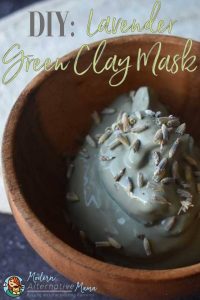Written by Kate Tietje and updated by Sarena-Rae Santos in October of 2023.
Recently, I decided it was time to get serious about healing my skin. You see, I’ve struggled with acne since I was a teenager. It got better and worse, mostly “better” as an adult, but when my hormones went nuts postpartum last year (so, I balanced my hormones) and then we were exposed to mold, it flared worse than it’s been in years. Although I finally got it to stop breaking out much and begin healing, I’m still dealing with a lot of redness, some scars and marks that won’t disappear, and the last of the spots healing.
I’ve been helping — oil cleansing and my acne salve — but it’s not enough. The long-term breakouts had damaged my skin, and I needed something stronger to help really heal. Hence, the lavender green clay mask. This would also be good for people with acne, rosacea, or other scarring.
I’ve used bentonite clay as a mask here and there, which is great for general use. I always have it around. But it’s not really for healing. French green clay, on the other hand, is meant for healing skin specifically. It’s rich in several important mineral oxides: magnesium, calcium, potassium, dolomite, silica, manganese, phosphorous, silicon, copper, and selenium. It also contains decomposed plant matter and volcanic ash. The clay absorbs and adsorbs (draws to itself) all of the junk in the skin and helps to start the healing process. Some sources even note that it has anti-bacterial properties (and acne can be caused or worsened by bacteria).
I paired this clay with lavender, also known to soothe and promote healing. This is a very simple combination to speed up the healing process. The mask is also very easy to prepare, with only three ingredients!
If you’re not interested in making your own, check out our store for a premade option — Earthley’s Lavender Green Clay Mask!
Lavender Green Clay Mask
Ingredients:
- 1 cup filtered water
- 3 tbsp. lavender buds
- 1/2 cup French green clay
Directions:
Step 1: Mix the water and lavender buds together in a small saucepan. Bring to a boil and remove from the heat.
Step 2: Allow this mixture to steep for 20 – 30 minutes (it’s okay to leave overnight if you’re busy; I did).
Step 3: Strain the lavender mixture.
Step 4: Mix the lavender “tea” with the clay until smooth in a small bowl. It will be thinner/soupier than a normal mask — don’t add more clay. It will thicken over the next few hours.
Step 5: Pour the mixture into an 8-oz. glass jar. Store it this way with a lid to keep it from drying out.
Using Your Mask
Since I’m trying to heal my skin, I use it daily for a little while (a week or so). Then, every couple of days, and eventually just once a week. You can use it once a week if you are just trying to keep your skin healthy. This is what I do to use it.
First, dip a washcloth in hot water. Place it over your face and leave it for a minute to help “steam” your face and open your pores. Then pat gently to get your skin wet.
Smear a small amount of the mask on your face, avoiding your eyes and mouth. Leave it on for 10 – 15 minutes. You might leave it less than that if it’s your first time using it. I found that while bentonite clay doesn’t do much to my skin, this green clay makes it throb and get itchy and sore. It’s very different.
Finally, use your washcloth with warm water to remove the mask and gently exfoliate. Pat with warm water, then switch to cold water and pat again to close your pores.
I follow the mask — which dries out my skin a bit — with this homemade acne salve. My skin tends to be red and inflamed for 20 – 30 minutes after removing the mask (which is different from bentonite clay). I figure this is helping it heal because each day, I see small improvements after the redness goes away!
I hope this is as helpful for you as it is for me!



Is this safe while nursing? I’ve been afraid to do any type of detox with bentonite clay as I’ve heard any detoxing isn’t safe. I know this uses a different type of clay though.
Do you think substituting lavender buds with lavender essential oil would be okay? I assume a 1% dilution in the mixture, but what do you think?
Hey! the green clay mask should be removed while still a bit damp- right before it get dry flaky & itchy. when the skin is damp at first it absorbs the minerals, when it starts to dry it exercises capillaries and stimulates blood flow and if gets fully dry it draws out the moisture from the surface of your skin, causing dehydration and irritation- not so good.
wishing us all beautiful & healthy skin, and a peaceful weekend <3
Rosie MC
If I use the bentonite clay using they same ingredient how long can I store it in a glass airtight container & do I have to refrigerate it??
Can you use lavender essential oil instead?
Totally random as this is an older article, but the link to the clay brought me to shoes from sketchers.
Hi Hannah, thank you for letting us know! We did have broken links next to the ingredients (I removed those). There is a link for our ready made green clay mask in there yet. That is https://www.earthley.com/product/lavender-green-clay-mask/